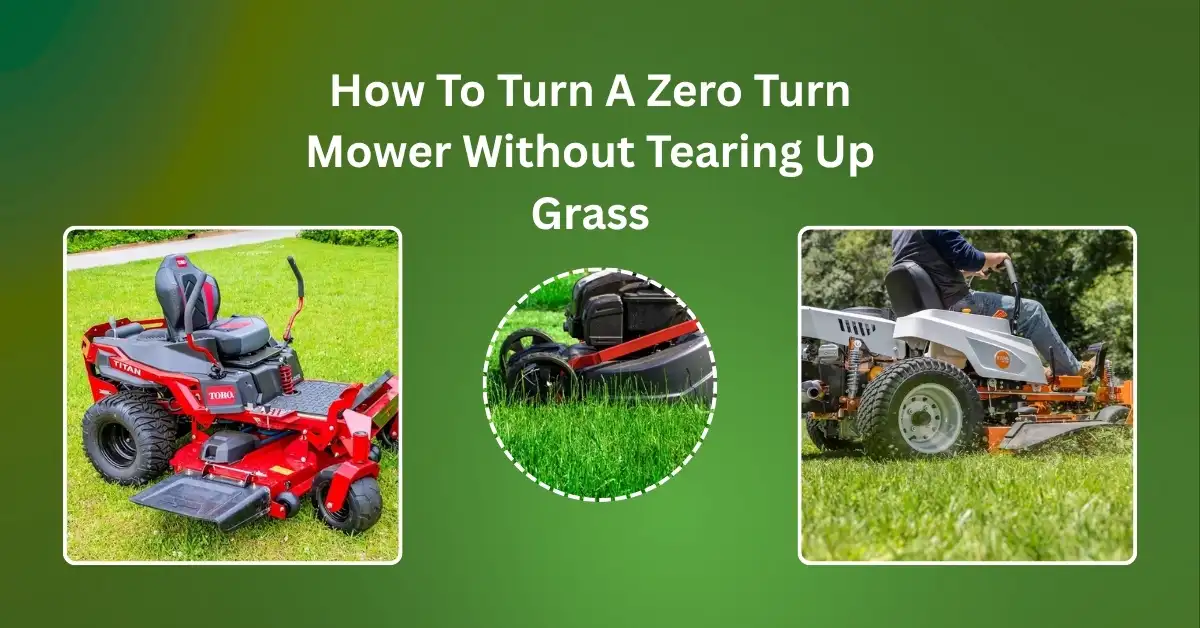How To Turn A Zero Turn Mower Without Tearing Up Grass

Ever spin your zero turn mower and leave a big patch of torn-up grass? I used to do that all the time. It was so frustrating to ruin a neat lawn with one bad turn. Learning how to turn a zero turn mower without tearing up grass changed everything. I’ll show you what worked for me—real tips, not just theory. Stick around, and I’ll help you mow cleaner, faster, and with way less stress.
Why This Happens in the First Place
When I got my first zero turn mower, I was excited. I thought I’d have the best-looking yard on the block. But after the first few runs, I saw torn spots and rough patches. My mower was tearing up the grass every time I turned.
Here’s why: zero turn mowers can spin in place. One wheel moves forward. The other moves back. This makes the turning radius zero. That sounds great—until you try it on soft grass. The wheels dig in and leave ugly marks.
At first, I didn’t know better. I made sharp turns to moved too fast and pivoted in place. Each time, I left behind more damage. These are common zero turn mower problems when turning.
So yes, the turning radius is zero. But that doesn’t mean you should spin in place. Wide, smooth turns work better. That simple shift saved my lawn.
Quick tip: If your mower jerks or tears the turf, slow down and turn wide. That’s the fix I wish I knew from day one.
The Right Way to Turn a Zero Turn Mower
If you’re tired of leaving bald spots in your yard, I get it—I’ve been there. But once I changed how I turned, everything got better. You don’t have to baby your mower, but you do need to work with it, not against it. Here’s what helped me fix the problem for good.
1. Slow Down Before You Turn
This is the biggest one. I used to zip around like I was racing the sun. But every fast turn left torn grass and wheel marks.
Going too fast is the #1 reason zero turn mowers tear up turf. When you move quick, the tires grip harder during turns—and that’s what rips the grass.
Now, I ease off the levers before turning. I take my foot off the gas (figuratively, since most are hand-controlled). I roll into the turn nice and smooth. It took some practice, but my lawn thanked me fast.
Quick tip: Slow down two seconds before the turn. You’ll feel more in control, and your grass will stay green and smooth.
2. Use a 3-Point Turn Instead of a Spin
The first time I saw someone whip a zero turn mower around on a dime, I thought, “Cool!” So I copied it. Bad idea. My yard looked like a racetrack with burnout marks.
Then I learned the trick: Use a 3-point turn. It’s way better for your lawn.
Here’s how I do it:
- First, slow down.
- Nudge one lever forward while easing the other one back, just a little.
- Pivot slightly.
- Then back up just a few inches.
- Finish the turn and keep going.
This move spreads the pressure across more ground. No spinning. No turf torn. Just a clean turn.
Use a 3-point turn anytime you’d normally pivot in place. It’s especially useful near garden beds, fences, or anywhere you want to keep the lawn looking sharp.
3. Practice on Less Visible Areas First
Honestly? I wrecked the edges of my front lawn for a week before I figured this out. The smart move would’ve been to practice in the backyard or behind the shed.
That’s what I did later. I picked a low-key patch of grass and just played with the controls and practiced slowing down, turning wide, and making 3-point turns To got a feel for the mower without the pressure of keeping things perfect.
Start in a hidden spot to get comfortable before hitting the main lawn. It helps you build muscle memory and confidence without leaving marks in the most visible areas.
My Top Zero Turn Mower Lawn Care Tips
Little changes that make a big difference.
After years of mowing, I’ve learned a few tricks that really help. These small tips can save your lawn and make mowing a lot smoother.
Keep Your Tire Pressure Balanced
At first, I didn’t think tire pressure mattered. But one day, my mower kept pulling to one side. The grass looked torn after every pass. I checked the tires—one was low.
Even a little change in pressure can throw things off. Your mower might turn too sharp or scuff the lawn. To stop that, check your tire pressure often. It keeps your turns smooth and protects the grass.
Sharpen Blades Often
I used to mow with dull blades without thinking twice. But I noticed the grass looked rough and ragged. That’s when I learned the blades were the problem.
Dull blades tear grass. That makes mowing harder and turning rougher. Sharp blades cut clean and smooth. I try to sharpen mine after every 20 hours of mowing. The mower runs easier—and the yard looks way better.
Mow in Different Patterns
For a long time, I mowed the same way each week. Same path. Same lines. It was easy, but after a while, ruts formed.
Now I switch things up. One week I mow side to side. Next week, front to back. Changing the pattern spreads out the wear. It keeps the lawn even and stops those grooves from forming.
Avoid Wet Grass and Slopes
I’ve made this mistake a few times—trying to mow right after rain. Or turning too fast on a slope. Every time, I ended up with ripped grass and deep tracks.
Wet ground is soft. Slopes can make the mower slip. If the grass feels soggy or the hill is steep, it’s better to wait. Mowing dry ground is safer and leaves fewer marks.
Troubleshooting Common Turning Issues
What I’ve run into—and how I fixed them.
Let’s be real: zero turn mowers are great, but they’re not always smooth. If your mower jerks, pulls, or just feels “off” during turns, you’re not alone. I’ve dealt with all of it. Here’s what I found out, and how I fixed each problem.
Mower jerks during turns? Check this first.
One day, my mower started jerking hard to the left whenever I turned. At first, I thought maybe the tires were low or the grass was too thick. Nope. The real problem? My hydraulic fluid was low.
If your zero turn mower jerks when turning, the first thing to check is the hydraulic fluid. Low or dirty fluid can mess with the steering and make the mower lurch.
Topping it off made a big difference. It’s also a good idea to check for air in the lines—some models need to be bled if they feel jumpy. I also cleaned around the pumps just in case gunk was slowing things down. Smooth as butter after that.
One side turns too fast or too slow? It’s usually a control linkage issue.
I had this weird thing where my left side felt lazy, like it was dragging. Turns were tight on one side and wide on the other. It made mowing crooked and frustrating.
Turns out, the control linkages under the seat had slipped out of alignment. If one side of your zero turn mower moves faster than the other, it’s likely the control linkages are out of sync.
A quick peek underneath showed me the left control arm wasn’t pushing the drive system as far as the right one. I loosened a nut, made a small tweak, and locked it back in. Boom—balanced movement.
When to adjust the control arms for smoother handling
When I first bought my mower, I figured everything came factory-perfect. Not true. After a few months, things started to feel uneven. The handles were a bit too loose, and I had to push one farther than the other to go straight.
That’s when I learned: if your mower pulls or drifts, it’s time to adjust the control arms. It’s not hard. Most mowers have bolts you can turn to even out the tension.
I adjusted mine little by little, testing each time. Once they were dialed in, the whole mower felt tighter, smoother, and easier to control. No more veering off course or wrestling the levers.
FAQs: Quick Answers for Zero Turn Turning Issues
Q1: How do you keep a zero turn mower from tearing the grass?
Slow down before turning. Don’t spin in place. That’s what tears the turf. I make wide, slow turns now. My grass stays clean and smooth.
Quick tip: Turn slow and wide to stop ripping up your lawn.
Q2: What’s the best way to learn how to drive a zero turn mower smoothly?
Practice in a spot where no one can see. I started in my backyard. That gave me time to learn. I went slow, tried wide turns, and got the hang of it.
Quick tip: Start in a quiet area and take it slow.
Q3: Why does my zero turn mower tear the grass when I turn?
These mowers can spin in place. One wheel moves forward, the other goes back. That sharp spin rips the grass, fast. I used to do that all the time.
Quick tip: Sharp spins cause turf damage—turn wide instead.
Q4: What is the turning radius of a zero turn mower?
It’s zero. That means the mower can turn on the spot. But doing that on grass? Bad idea. It tears the turf every time.
Quick tip: A zero turn mower can pivot in place—but don’t do that on soft grass.
Q5: Are there lawn care tips specific to zero turn mowers?
Yes! Keep tires full. Sharpen the blades. Don’t mow wet grass. Change your mowing pattern each time. These small steps help a lot.
Quick tip: Tire pressure, sharp blades, and dry grass keep your lawn safe.
Final Thoughts: Practice Makes Perfect (and Preserves Your Lawn)
When I first got my zero turn mower, I thought I could master it in a day. I didn’t. I tore up patches of grass every time I turned. It took me about three weeks of trial and error to stop wrecking my lawn.
Short answer: Most people need a few weeks to get smooth with a zero turn mower.
But here’s the thing—power isn’t what makes you good at mowing. It’s patience. I had to slow down, learn how the machine moved, and stop treating it like a race car. The mower has speed, but control matters more.
Quick tip: Slow turns and patience protect your grass more than power ever will.
If you’re new to this, don’t worry. We all start somewhere. I wish someone had told me not to practice on the front yard. I’d have saved myself some awkward looks from neighbors. Start in a hidden spot. Learn the controls. Try different turns.
Beginner tip: Practice in less visible areas until you feel confident.
The more you mow, the better you’ll feel behind the levers. You’ll stop second-guessing your turns. You’ll flow with the mower instead of fighting it. It’s like riding a bike—awkward at first, then smooth as butter.
Key takeaway: Mowing gets easier every time you do it—just give yourself space to learn.
Most of all, enjoy the process. I never thought mowing could be relaxing, but now it’s almost like therapy. A clean cut, a smooth turn, and a fresh-looking lawn? That’s a win in my book.
Final thought: With time and practice, mowing becomes less of a chore and more of a joy.
Read More: Is a Zero Turn Mower Worth It? The Hidden Disadvantages
